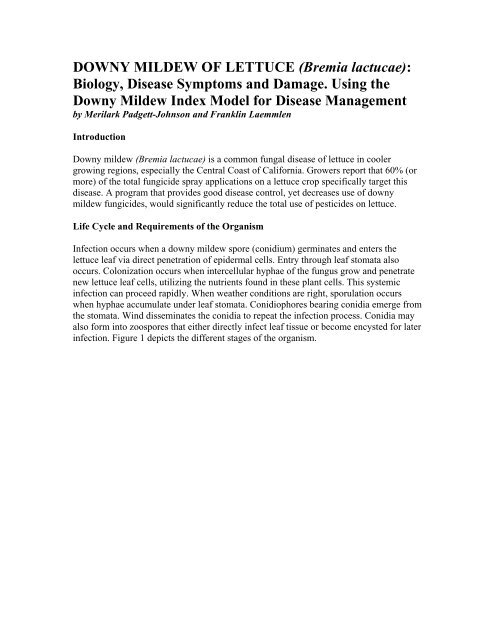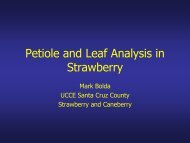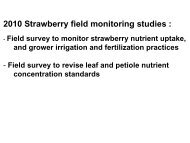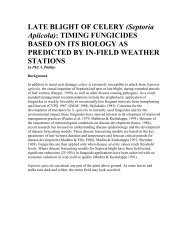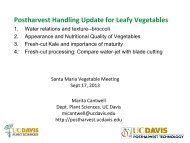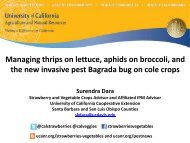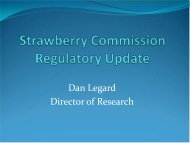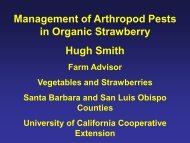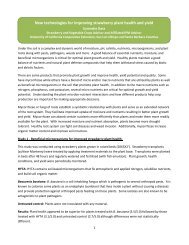DOWNY MILDEW OF LETTUCE (Bremia lactucae) - Santa Barbara ...
DOWNY MILDEW OF LETTUCE (Bremia lactucae) - Santa Barbara ...
DOWNY MILDEW OF LETTUCE (Bremia lactucae) - Santa Barbara ...
- No tags were found...
Create successful ePaper yourself
Turn your PDF publications into a flip-book with our unique Google optimized e-Paper software.
<strong>DOWNY</strong> <strong>MILDEW</strong> <strong>OF</strong> <strong>LETTUCE</strong> (<strong>Bremia</strong> <strong>lactucae</strong>):Biology, Disease Symptoms and Damage. Using theDowny Mildew Index Model for Disease Managementby Merilark Padgett-Johnson and Franklin LaemmlenIntroductionDowny mildew (<strong>Bremia</strong> <strong>lactucae</strong>) is a common fungal disease of lettuce in coolergrowing regions, especially the Central Coast of California. Growers report that 60% (ormore) of the total fungicide spray applications on a lettuce crop specifically target thisdisease. A program that provides good disease control, yet decreases use of downymildew fungicides, would significantly reduce the total use of pesticides on lettuce.Life Cycle and Requirements of the OrganismInfection occurs when a downy mildew spore (conidium) germinates and enters thelettuce leaf via direct penetration of epidermal cells. Entry through leaf stomata alsooccurs. Colonization occurs when intercellular hyphae of the fungus grow and penetratenew lettuce leaf cells, utilizing the nutrients found in these plant cells. This systemicinfection can proceed rapidly. When weather conditions are right, sporulation occurswhen hyphae accumulate under leaf stomata. Conidiophores bearing conidia emerge fromthe stomata. Wind disseminates the conidia to repeat the infection process. Conidia mayalso form into zoospores that either directly infect leaf tissue or become encysted for laterinfection. Figure 1 depicts the different stages of the organism.
Downy mildew conidia require free water on the leaf surface for germination andinfection. The heavy fogs and dews that occur on the Central Coast provide optimalconditions. Colonization proceeds when temperatures are around 21°C (70°F).Sporulation requires high relative humidity.Symptoms and DamageLeaf symptoms of downy mildew first show as angular, pale yellow patches which aredelineated by leaf veins. The first leaves of the lettuce plant or older leaves close toground usually are the first to show symptoms. The underside of the leaf opposite theyellow patch will show white masses of spores from 7 to 14 days after infection. As thespore mass grows larger, it takes on a white, downy appearance; hence the name downymildew. As the disease spreads, the upper side of the leaves may also show the downywhite fungus growth. Downy mildew can reduce yields and quality of the crop. Infectedwrapper leaves must be removed at harvest. Infections on the cap leaves may result inleaving heads behind in the field. Downy mildew damaged leaf tissue can be an entry sitefor secondary rot producing organisms. These rot organisms may compound crop lossesin the field, and can also cause losses later when the lettuce is in transit.
Disease Management and the Downy Mildew IndexThere are downy mildew resistant varieties of iceberg lettuce, but no cultivar issufficiently resistant to all the races of downy mildew to allow culture without fungicides.Both systemic and contact fungicides are necessary in a spray program to combat downymildew. Control of the disease depends upon good coverage with the fungicide material,timely first applications, and repeated applications as weather and disease developmentdictate. Currently maneb, fosetyl-A1, and at times, copper compounds are the primaryfungicides used for disease suppression. Because weather conditions on the Central Coastare mostly conducive to downy mildew infections and spread, calendar spray applicationsare the norm. However, there are times when weather conditions are not conducive todowny mildew infection and sporulation. Closely monitoring weather conditions todetermine precisely the risk potential for downy mildew infections is the purpose of theDowny Mildew Index.In-field weather stations collect pertinent weather data; these being temperature, relativehumidity, wind speed and direction, leaf wetness, solar radiation intensity, and soilmoisture content. The Downy Mildew Index compiles and analyzes these data.Conditions conducive to <strong>Bremia</strong> <strong>lactucae</strong> infection and spread accumulate "points," andconditions that deter downy mildew subtract "points." The Downy Mildew Index isexpressed as a number; the greater the number, the higher the risk of infection anddisease development, and the lesser the number, the lower the infection risk.The Downy Mildew Index is being tested and validated in Lompoc and <strong>Santa</strong> MariaValley commercial lettuce fields. Eliminating fungicide spray applications when they arenot necessary, yet insuring good disease control, is the goal.Resources for Further InformationDr. Phil Phillips, U.C. Cooperative Extension IPM Specialist - 805/645-1457.Dr. Franklin Laemmlen, Plant Pathologist and Vegetable Crops Farm Advisor, <strong>Santa</strong><strong>Barbara</strong> County - 805/934-6240.Carla Thomas, Plant Pathologist and Disease Modeling Specialist - 707/480-3306.This publication was made possible, in part, through a funding grant from theCal/EPA, Department of Pesticide Regulation, Pest Management Analysis andPlanning Program, and the U.S. Environmental Protection Agency.Franklin Laemmlen, UC Farm Advisor Phil Phillips, UC Farm Advisor Julie Newman, UC Farm Advisor624 West Foster Road 669 County Square Drive, #100 660 County Square Drive, #100<strong>Santa</strong> Maria, CA 93455 Ventura, CA 93003 Ventura, CA 93003


